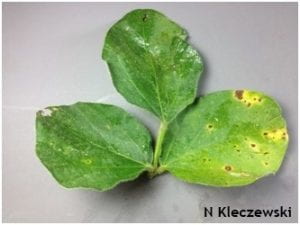Nathan Kleczewski, Extension Specialist – Plant Pathology; nkleczew@udel.edu
Several diseases can be currently found in full season soybeans. I came across the following when scouting grower fields in New Castle County this week. If you have fields that you would like me to check, feel free to contact me at nkleczew@udel.edu or call my office. I’d be more than happy to stop by.
Brown Spot
This is a very common disease in Delaware soybean fields, and rarely does it cause significant yield losses. However, some yield loss may occur during extremely wet growing seasons. Brown spot is caused by the fungus, Septoria glycenes. As the very creative name implies, this pathogen causes brown spots on foliage (Figure 1) and to a lesser extent, stems and pods. Initial symptoms appear first on cotyledons and unifoliate leaves early in the vegetative growth stage and may progress up the plant as it grows. Irregular, brown to red-brown spots can be seen on the upper and lower leaf surfaces. Severely infected leaves turn yellow and fall off the plant. The pathogen is residue-born and some control can be achieved by crop rotation and tillage, although it is rarely economically feasible to manage this disease.
Figure 1. Brown spot on soybean
Downy Mildew
Downy mildew can be currently seen on the upper canopy on soybean plants, and its incidence and severity are very low. The disease is caused by a fungus-like organism called Peronospora manshurica. Symptoms can be seen as small pale green to yellow spots on the upper surface of leaves. If you flip the leaf over you may see a grey to white fuzz on the opposite side of the spots. The pathogen can be borne on either residue or seed. Infection requires long periods of wet weather and cool to moderate temperatures. Downy mildew is rarely yield limiting in soybean, so control is not warranted.
Frogeye Leaf Spot
Frogeye leaf spot was very sparse and only observed at extremely low levels in a single field. The disease can be problematic in some years where environmental conditions favor the disease. The disease is caused by the fungus Cercospora sojina. The pathogen produces tan to brown spots with a Baltimore Ravens purple halo (Figure 2). When inspecting lesions with a hand lens, it may be possible to see black dots with grey/silver-colored spores at the center. If the pathogen infects the pods, seeds can become infected, causing them to turn purple and shrivel. Because the pathogen infects young leaves more readily than older leaves, plants can have a layered appearance, where lesion size on the canopy increases as you move up the plant. Warm wet conditions, especially warm nights with heavy dews, favor disease development. C. sojina overwinters in soybean residue and is spread short distances by wind and rain. Within season management, when warranted, can be achieved with fungicides. However, it is important to note that resistance of C. sojina to group 11 fungicides (strobilurins) has been reported in Arkansas, Kentucky, Illinois, Tennessee, and Missouri. As a result, group 11 fungicides are considered “high risk” fungicides for control of this pathogen. Consequently, group 11 fungicides should be tank mixed with other fungicides that belong to a different fungicide group and are labeled for Frogeye leaf spot. These will most likely be triazole (DMI-group 3) fungicides. Between-season management includes using resistant varieties, crop rotation, tillage where appropriate, and the use of disease-free seed. The 2013 soybean fungicide list and ratings can be found on my blog: http://extension.udel.edu/fieldcropdisease/.
Figure 2. Frogeye leaf spot on soybean
Soybean Cyst Nematode
You also may see yellow patches of soybeans in some fields, particularly higher areas of the field or in sandy soils. When you dig up the plants, tiny white or yellow pearls may be observed on roots. These are much smaller than nodules; the inside of a nodule will be red/pink in color when cut open. If you have SCN confirmed in a field, you should strongly consider submitting a soil sample to the diagnostic clinic at the end of the growing season to determine your SCN levels. Remember that symptoms are not always present on plants infected with SCN.
As usual, please contact your local county agent, myself (nkleczew@udel.edu), or submit a sample to the University of Delaware Diagnostic Clinic if you have any potential plant disease issues. Also, try to stay cool out there!
This week’s Field Crop Disease Management Blog topic is Reproduction on Soybean Cyst Nematode on SCN Resistant Varieties.


